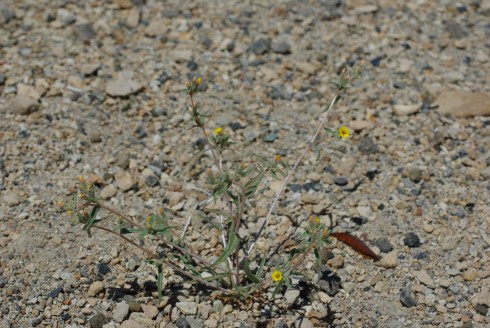Over the past several weeks, I have gradually been immersed into a whole new world: research. Often, it was intimidating; I found myself in positions of uncertainty and insecurity. I messed up a lot, which was humbling. But more importantly, I learned a lot. Research, I realized, is a learning process. Mistakes and frustrations don’t define the experience, rather our responses to these stressors do.
What exactly have I been researching? My research pertains to a plant known as Mentzelia monoensis, an allopolyploid endemic to Mono Co., California. While I won’t go into extensive detail (that’s what the introduction is for!), many difficulties arise in identifying the species from its relatives (due primarily to overlapping morphological characteristics). As the species’ true distribution is presently unknown, it is important to develop effective mechanisms to facilitate identification. Currently, we are planning on utilizing DNA barcoding, a method that utilizes short genetic markers to identify unknown specimen. Below I have included the beginning of the introduction that I am writing for a paper that we would like to publish about this research.
My partial introduction, as posted, reflects part of this learning process. Often when I write, I want to use big words, words that procure (see, words like procure) the greatest effect. However, I discovered that flowery language can often confuse readers, especially in papers that already address difficult concepts. In writing scientific papers especially, message supersedes style. Clear communication is key. Likewise, there is no harm in having other professionals aid you in the writing process. Sometimes this can reveal weaknesses in your writing that you don’t notice.
Additionally, expertise is not a precursor to conducting research. This might sound a bit obvious, however perspective has a funny way of affecting thinking. Prior to researching, I felt that I had to be a walking textbook—I had to memorize and regurgitate all of the information I was given. But I soon discovered that memorization, though a useful skill, does not compensate for understanding. I could memorize all the steps in gel electrophoresis, but I didn’t understand the process until I actually performed one myself. Moreover, you don’t have to be an “expert” in the field you’re in researching in, especially initially. I will be the first to admit that I’m a novice when comes it comes to plants (especially compared to Dr. Brokaw). But that’s okay; I don’t have to be an expert (and I am certainly not expected to be).
My advice: try it. You never truly know how much (or how little) you’ll enjoy something until you experience it yourself. You might doubt your own abilities or feel intimidated by the new situations, but don’t let your fears impede the opportunities God places in your life. Rather, embrace what is given to you and share your abilities with the world.
Introduction:
Mentzelia section Trachphytum is a monophyletic group comprised of roughly 20-30 annual species in western North America, particularly in California (Darlington 1934; Zavortink 1966; Hufford et al. 2003; Brokaw and Hufford 2010a, b). Trachyphytum is unique among sections of Mentzelia for its high number (approximately 2/3 of the named taxa) of polyploid species (Zavortink 1965). The section is generally composed of species that either tolerate extreme soil conditions or colonize disturbed sites. Mentzelia monoensis, is a recently described hexaploid species that lives in course pumice soils and disturbed sites of Mono Co., California (Zavortink 1965; Brokaw and Hufford, 2011). This species is of particular interest because of its unique allopolyploid origin (Brokaw and Hufford, 2010b). Mentzelia monoensis is the only allopolyploid within Trachphytum formed through a hybridization involving the two predominant clades, “Affines” and “Trachphyta” (Brokaw and Hufford, 2010b).
Recently, some experts have considered elevating M. monoensis to threatened status, and the California Native Plant Society currently ranks M. monoensis as a 4 (Plants of Limited Distribution), which indicates the species could potentially be vulnerable to environmental change (http://www.rareplants.cnps.org/detail/3657.html). From collected data, the species appears to be narrowly distributed near Mono Lake and has only been observed in Mono Co., California (Brokaw and Hufford, 2011). The Mono Lake region itself has piqued the interest of conservationists as a result of unnatural diversion of water pathways to Southern California, resulting in extreme environmental change and, potentially, species endangerment (citation). However, our current knowledge of the distribution of M. monoensis is only tentative. This deficiency stems from both the short amount of time that M. monoensis has existed as a described taxon and, more markedly, the difficulty in distinguishing the species from others in Trachphytum (Brokaw and Hufford, 2011).
Morphologically, M. monoensis closely resembles other species in Trachyphytum, especially M. montana and M. albicaulis. Upon close inspection, one can usually identify M. monoensis based on knowledge of seed coats, floral bracts, and leaf color (Brokaw and Hufford, 2011). However, identification can be time consuming and cumbersome, especially among those unfamiliar with Mentzelia. Furthermore, these characters are not available in all developmental stages. Morphological similarities between M. monoensis and its relatives can be attributed to two primary factors: allopolyploidy and time. First, most polyploid species in Trachyphytum are allopolyploids, which in turn leads to overlapping morphological variation in the section (Brokaw and Hufford, 2010b). Second, M. monoensis is a recently formed polyploid, meaning that it may not have had adequate time to develop unique morphological traits. Consequently, M. monoensis—because of its recent speciation—cannot be reliably distinguished from its progenitors, including M. montana (Brokaw and Hufford, 2011).

